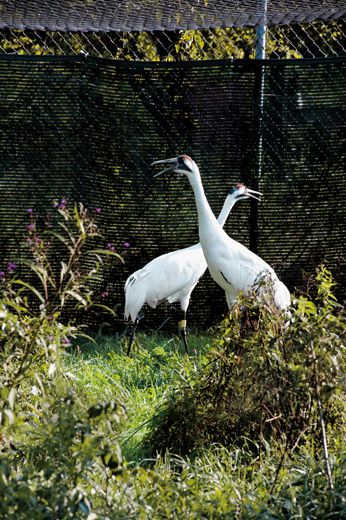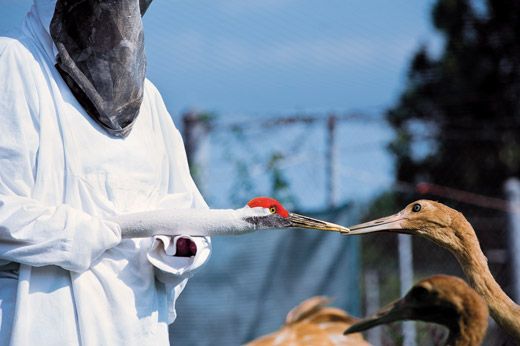A Call to Save the Whooping Crane
Smithsonian researchers join an international effort to bring the five-foot-tall bird back from the brink of extinction
/https://tf-cmsv2-smithsonianmag-media.s3.amazonaws.com/filer/Walking-Tall-Jane-Chandler-631.jpg)
“You see how his nose is up in the air and he is walking a little more stiff-legged,” Megan Brown is saying while watching a video on her laptop. “That’s called marching.” On her screen, the larger of two whooping cranes flaunts his outstretched wings, showing that he’s ready to breed. Typically, the female reciprocates the gesture. Instead, she ignores him. “She is not in the mood, I guess,” says Brown, sounding dejected.
Getting whooping cranes to make whoopee has been Brown’s focus for three years. A graduate student in animal and avian sciences at the University of Maryland, she is helping to conduct research at the Smithsonian Conservation Biology Institute (SCBI), a Front Royal, Virginia-based facility associated with the National Zoo in Washington, D.C. The institute is participating in a project to increase the whooping crane population, which plummeted to less than two dozen animals in the 1940s.
Seen up close, the whooping crane leaves little doubt that birds are descendants of dinosaurs. Standing five feet tall, they have intense gold eyes, long spear-like beaks, pure white plumage, red caps and black facial markings. Historically, the leggy birds summered in areas stretching from Alberta, Canada, to southern Wisconsin and wintered in Texas, northern New Mexico and spots along the Atlantic Coast. In 1870, there were thought to be between 500 and 1,400 whooping cranes living in the wild. But as people drained the birds’ wetland habitat for agriculture and hunted them for their feathers, their numbers dwindled.
In 1967, the U.S. Fish & Wildlife Service and the Canadian Wildlife Service began collecting viable crane eggs and brought them to a captive-breeding facility at the Patuxent Wildlife Research Center in Laurel, Maryland. Other breeding programs followed, but Patuxent remains home to the largest captive flock, with 72 adult cranes. Between the eggs the center’s flock produces and those sent by other facilities, Patuxent hatches and rears, on average, 20 to 30 chicks each year.
Patuxent has also developed methods to ensure that most of the chicks survive, migrate and find mates once they are released into the wild. From the moment the cranes hatch, handlers wear white gowns and masks so that the birds imprint on something resembling an adult crane. Using crane puppets and MP3 devices that play recordings of whooping crane calls, the handlers teach the chicks to eat, and lead them on walks for exercise.
Yet for all the program’s successes, Patuxent’s handlers and scientists are concerned that only about 55 percent of the eggs are fertile.“It would be great if we could have it much closer to 90 percent,” says Sarah Converse, a research ecologist.
That goal led Patuxent to contact SCBI, which has made major advances in understanding the reproduction of such endangered species as giant pandas and cheetahs.
“Our Smithsonian colleagues will hopefully help us identify problems with particular pairs,” says the flock manager, Jane Chandler. These can include low sperm quality, genetic incompatibilities or nutritional deficiencies.
One promising line of research is the birds’ hormone levels. For about five months this spring, SCBI’s Brown and her adviser, reproductive physiologist Nucharin Songsasen, set up cameras and recorded the behavior of six breeding pairs around sunrise each day (when they tend to be particularly randy). Meanwhile, handlers put capsules filled with dye—one color for males and another for females—in fish, which they fed to the cranes. Three times a week, Brown collected color-coded feces from the pens, and late this summer she measured hormone byproducts in the samples. She is now reviewing more than 1,000 hours of video to see how the cranes’ behavior correlates with the hormone data.
In particular, Brown and Songsasen are looking for hormone levels that would indicate whether the birds are stressed—a condition that could be caused by environmental factors, such as too-small holding pens. “The energy that they are using being stressed, they can’t use toward reproduction,” Brown explains.
Even if researchers manage to increase fertility rates, the whooping crane is likely to remain endangered for “many years to come,” says Marshall Jones, a senior conservation adviser at SCBI. In the meantime, though, 437 whooping cranes are reportedly living in the wild. “It’s certainly been a success,” says Jones. “But it’s taken a concentrated international effort, with people from lots of institutions, spending almost their whole careers just working on whooping cranes.”
/https://tf-cmsv2-smithsonianmag-media.s3.amazonaws.com/accounts/headshot/megan.png)



/https://tf-cmsv2-smithsonianmag-media.s3.amazonaws.com/accounts/headshot/megan.png)